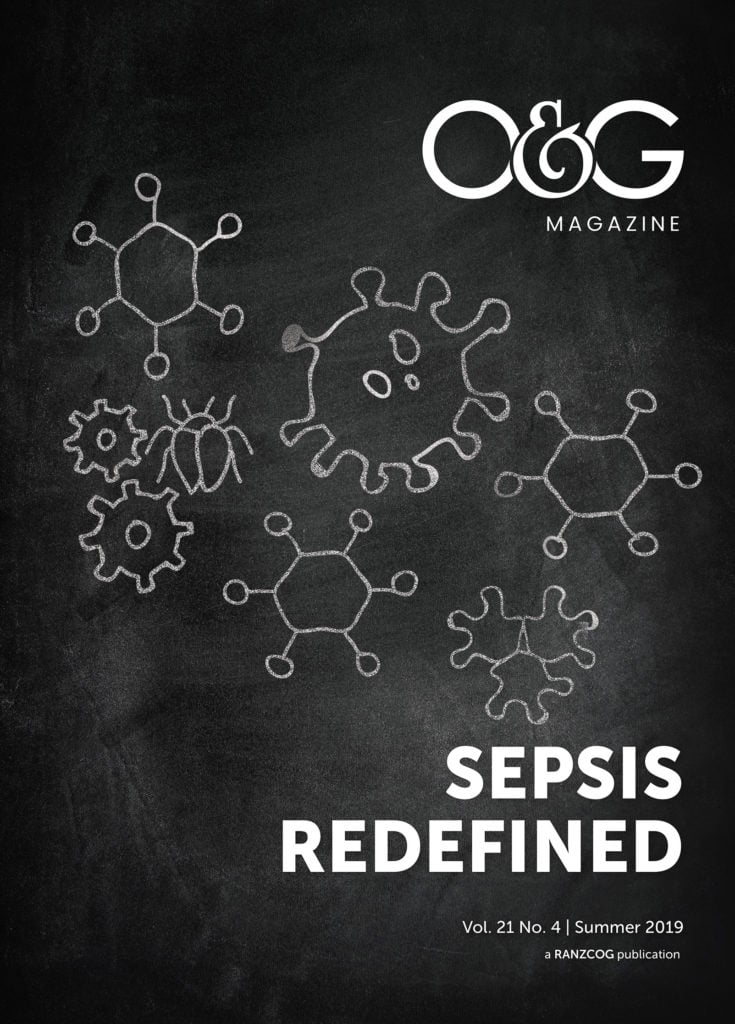Clinical scenario: A 25-year-old woman presents to the emergency department with lower abdominal pain and a three-day history of abnormal discharge. She has no significant medical history and uses a Mirena for contraception. On examination she is afebrile, with a heart rate of 80 and blood pressure at 124/60. She is tender in both adnexae and has cervical motion tenderness. Her bloods show elevated white cells and neutrophils, and a pelvic ultrasound is normal.
Pelvic inflammatory disease
The above scenario demonstrates a common presentation of pelvic inflammatory disease (PID). PID is an infection-induced inflammation of the upper female genital tract. Infection generally spreads from the lower genital tract to the pelvis. STIs, including chlamydia and gonorrhoea, are implicated in PID; however, other vaginal bacteria can also cause pelvic infection. PID is commonly a polymicrobial infection. In many instances, a single causative organism is not isolated and the absence of a pathogen does not rule out the diagnosis of PID.
Although mortality from PID is rare, the sequalae of infection and inflammation may be serious. Diagnosis relies on a high index of clinical suspicion as symptoms and signs can be subtle and definitive testing for lower genital tract organisms can take time. Early treatment is necessary to prevent long-term consequences, such as infertility and pain. Antibiotic treatment is therefore commonly commenced based on clinical findings alone. In summary, in women with the possibility of PID as their diagnosis, it is prudent to be suspicious and treat early.
Risk factors
Disruption of the cervical epithelium and usual cervicovaginal pH and microbial environment allow lower genital tract microbes to ascend and cause infection and inflammation in the upper genital tract. This disruption may be caused by sexually acquired infections, vaginal microbial imbalances, such as bacterial vaginosis (BV), or mechanically via instrumentation, surgery or pregnancy-related procedures.
Table 1. Risk factors for PID. 1
| Sexual | Non-sexual |
| Age <30 | IUD insertion in the past 6 weeks |
| Recent change in sexual partner | Termination of pregnancy |
| Multiple sexual contacts | Postpartum state |
| Previous STI | Upper genital tract instrumentation |
| IVF |
Microbiology
The majority of acute PID is caused by sexually acquired infections, such as Chlamydia trachomatis, Neisseria gonorrhoea and Mycoplasma genitalium, and bacterial vaginosis-related organisms, such as the bacteroides species, Mycoplasma hominis and Ureaplasma urealyticum. Additionally, 15 per cent of acute PID is related to bowel or respiratory organisms that have colonised the lower genital tract, such as E. coli, Group B Streptococcus, Haemophilus influenza and Streptococcus pneumoniae.2
Chlamydia is the most common sexually transmitted cause of PID, and approximately 15 per cent of women with either chlamydia or gonorrhoea infections go on to develop PID.3 The reason that progression to PID occurs for some women and not others is unclear.
BV is a polymicrobial clinical syndrome caused by a change from predominantly lactobacillius organisms to other organisms, including a high number of anaerobes and biofilm formation on the vaginal wall. The pH of the vagina rises and local enzymes that degrade cervical mucous are produced. BV is not sexually transmitted, but may be acquired through sexual activity. Women with BV are more likely to develop PID after termination of pregnancy and IUD insertion, and are 2–3 times more likely to contract other STIs, such as chlamydia and gonorrhoea.4 5 6
Mycoplasma genitalium is an established cause of PID and understanding its role is rapidly evolving. Clinical features and risk factors are similar to chlamydia. Patients with Mycoplasma genitalium should be referred to a sexual health physician and require additional antibiotic management to the usual PID regimen, with consideration to high rates of antibiotic resistance.7
Clinical management of PID
Women presenting with PID may report pelvic or lower abdominal pain, abnormal vaginal discharge, intermenstrual or postcoital bleeding, dyspareunia, dysuria and right upper quadrant pain with a pleuritic nature.
On physical examination, pelvic tenderness and evidence of lower genital tract inflammation together are highly suggestive of PID. Bimanual examination is necessary to check for cervical motion tenderness, adnexal tenderness and masses. The absence of pain has a high negative predictive value. Right upper quadrant tenderness is suggestive of Fitz-Hugh-Curtis Syndrome, a perihepatitis involving inflammation of the liver capsule and peritoneal surfaces, present in approximately 10 per cent of women with acute PID.8
Speculum examination allows assessment of the cervix; mucopurulent discharge supports the diagnosis. Cervical friability with contact bleeding also suggests cervicitis. Fever can occur, but systemic illness is not a necessary feature of PID.9
Differential diagnosis of PID includes ectopic pregnancy, appendicitis, UTI, complications of an ovarian cyst such as rupture or torsion, endometriosis, irritable bowel syndrome or diverticular abscess.
Investigations
Endocervical swab for nucleic acid amplification testing
- Testing for chlamydia, gonorrhoea and Mycoplasma genitalium
- Urine protein/creatinine ratio for chlamydia is less sensitive than endocervical swab
- Negative sexually acquired infection screen does not exclude PID
High vaginal swab
- Testing for candida, bacterial vaginosis and trichomoniasis
Bloods
- FBC: may show elevated white cell count and neutrophilia
- CRP: Elevated inflammatory markers support the diagnosis but are a non-specific finding
Pelvic ultrasound
- Check for tubo-ovarian abscess
- Rule out other differential diagnoses, such as ovarian cyst events or appendicitis
- May be normal in PID
Rule out concurrent infection and other diagnoses
- Pregnancy test
- HIV and syphilis serology
- Selective hepatitis B/C screening based on immunity and risk factors
Laparoscopy and endometrial biopsy are not routinely performed for diagnosis of PID.
Inpatient or outpatient management
Hospital admission for intravenous antibiotics, observation and possible surgical intervention should be considered if:
- there is diagnostic uncertainty
- there is clinical failure of, or inability to, tolerate oral therapy
- symptoms are severe or there are signs requiring inpatient treatment
- tubo-ovarian abscess
Management of PID
Antibiotic treatment should start with the provisional diagnosis of PID, without waiting for test results, in women with lower abdominal pain plus cervical, uterine or adnexal tenderness. Pain can be severe, and patients may need admission for analgesia.
Antibiotic choice and dose should be guided by current local guidelines and patient factors. Combinations of a cephalosporin, metronidazole, azithromycin and doxycycline are commonly used.
It is recommended that sexual contacts in the last three months should have a sexual health check and appropriate treatment. If an organism is identified, contacts should be traced and treated as per the sexual health guidelines for that organism. Advise women to avoid intercourse for two weeks after commencing treatment, and one week after contact treatment.
Complications
Complications of PID include tubo-ovarian abscess, infertility, ectopic pregnancy and chronic pelvic pain. Long-term consequences are more likely in women with recurrent or severe PID; however, they may occur despite early diagnosis and successful treatment.
Tubo-ovarian abscesses can be managed either conservatively with intravenous antibiotics, by interventional radiology-guided drainage, or, surgically. There is no consensus on when to attempt conservative versus surgical management, and conservative management will fail in 20–30 per cent of patients. Larger abscesses are less likely to respond to antibiotics alone. Abscess size greater than 5.5–6.5 cm predicts failure of conservative management.10 11 In women desiring future fertility, early operative management improves future pregnancy outcomes. Early surgical management should also be considered for post-menopausal women who may have associated malignancy.
Infertility due to PID is caused by tubal inflammatory damage, loss of ciliated tubal epithelium and adhesions causing partial or total tubal obstruction. There is higher risk of infertility if PID is caused by chlamydia, if treatment is delayed, in recurrent PID and after severe disease. Tubal damage also increases the risk of ectopic pregnancy.
In the case of PID in the presence of an IUD, the routine removal of an IUD does not hasten clinical resolution;12 however, removal should be considered if there is no clinical improvement in 48–72 hours.
Summary
PID is a polymicrobial upper genital tract infection that may be sexually or non-sexually acquired. High clinical suspicion is required in women presenting with potential PID, although some may be asymptomatic or have mild symptoms. Treatment should be commenced based on clinical findings as delay increases the risk of long-term negative sequelae.
References
- New Zealand Sexual Health Society Best Practice Guidelines. Pelvic Inflammatory Disease: management summary 2017. Available from: www.nzshs.org/docman/guidelines/management-of-sexual-health-conditions/pelvic-inflammatory-disease/171-pid-guideline/file
- New Zealand Sexual Health Society Best Practice Guidelines. Pelvic Inflammatory Disease: management summary 2017. Available from: www.nzshs.org/docman/guidelines/management-of-sexual-health-conditions/pelvic-inflammatory-disease/171-pid-guideline/file
- Ross J. Pelvic inflammatory disease: Pathogenesis, microbiology and risk factors. UpToDate. 2019. Available from: www.uptodate.com/contents/pelvic-inflammatory-disease-pathogenesis-microbiology-and-risk-factors.
- Brunham RC, Gottlieb SL, Paavonen J. Pelvic Inflammatory Disease. N Engl J Med. 2015;372:2039-48.
- New Zealand Sexual Health Society Best Practice Guidelines. Pelvic Inflammatory Disease: management summary 2017. Available from: www.nzshs.org/docman/guidelines/management-of-sexual-health-conditions/pelvic-inflammatory-disease/171-pid-guideline/file
- Australian Sexual Health Alliance. STI Management Guidelines for use in Primary Care: Bacterial Vaginosis.2018. Available from www.sti.guidelines.org.au/sexually-transmissible-infections/infections-associated-with-sex/bacterial-vaginosis#clinical-presentation.
- Australian Sexual Health Alliance. STI Management Guidelines for use in Primary Care: Mycoplasma Genitalium. 2018. Available from: www.sti.guidelines.org.au/sexually-transmissible-infections/mycoplasma-genitalium#follow-up.
- Ross J, Chacko M. Pelvic inflammatory disease: Clinical manifestations and diagnosis. UpToDate. 2018. Available from: www.uptodate.com/contents/pelvic-inflammatory-disease-clinical-manifestations-and-diagnosis.
- New Zealand Sexual Health Society Best Practice Guidelines. Pelvic Inflammatory Disease: management summary 2017. Available from: www.nzshs.org/docman/guidelines/management-of-sexual-health-conditions/pelvic-inflammatory-disease/171-pid-guideline/file
- Chu L, Ma H, Liang J, et al. Effectiveness and adverse events of early laparoscopic therapy versus conservative treatment for tubo-ovarian or pelvic abscesses: a single-centre retrospective cohort study. Gynecol Obstet Invest. 2019;84(4):334-42.
- Inal ZO, Inal HA, Gorkem U. Experience of Tubo-ovarian abscess: a retrospective clinical analysis of 318 patients in a single tertiary centre in middle Turkey. Surgical Infections. 2018;19(1):54-60.
- New Zealand Sexual Health Society Best Practice Guidelines. Pelvic Inflammatory Disease: management summary 2017. Available from: www.nzshs.org/docman/guidelines/management-of-sexual-health-conditions/pelvic-inflammatory-disease/171-pid-guideline/file







Leave a Reply